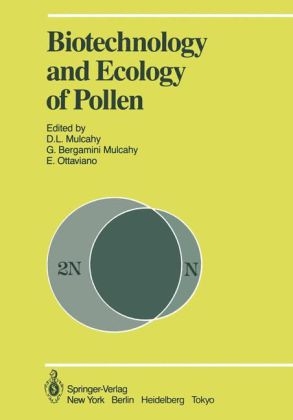
Biotechnology and Ecology of Pollen
Springer-Verlag New York Inc.
978-0-387-96267-2 (ISBN)
- Titel ist leider vergriffen;
keine Neuauflage - Artikel merken
Gene Expression in Pollen.- Expression of ?-Galactosidase Gene in Pollen of Brassica campestris.- Identification of Duplicate Loci and Evidence for Post-meiotic Gene Expression in Pollen.- Gametophytic Gene Expression in Embryo-lethal Mutants of Arabidopsis thaliana.- Pollen Competitive Ability in Maize Selection and Single Gene Analysis.- Extent of Gene Expression at the Gametophytic Phase in Maize.- Male Gametophyte Response to High Temperature in Maize.- Genes and their Expression in the Male Gametophyte of Flowering Plants.- Pollen in Biotechnology.- Chromosome Engineering with Meiotic Mutants.- Intergeneric Crosses Between Zea and Pennisetum Reciprocally by In Vitro Methods.- Gametophyte Transformation in Maize (Zea mays, Gramineae).- Attempts to Transform for Kanamycin-Resistance in Mature Pollen of Tobacco.- Attempted Pollen-mediated Transformation using Ti-plasmids.- Dissolution of Pollen Intine and Release of Sporoplasts.- Sporophytic Screening and Gametophytic Verification of Phytotoxin Tolerance in Sugarbeet (Beta vulgaris L.).- Predicting Species Response to Ozone using a Pollen Screen.- In Vitro and in Vivo Effects of Acidity and Trace Elements on Pollen Function.- Alfalfa Pollen and Callus Responses to Fusarium.- Induction of Gametic Selection in situ by Stylar Application of Selective Agents.- Factors Influencing Artificial Gametophyte Selections using Synthetic Stigmas.- In Vitro Reaction Between Apple Pollen and Apple Scab Fungus (Venturia inaequalis Cke. Wint.).- Pollen Selection in Breeding Glasshouse Tomatoes for Low Energy Conditions.- Biochemical Alterations in the Sexual Partners Resulting from Environmental Conditions before Pollination Regulate Processes after Pollination.- The Use of In Vitro Methods in the Production of Pollen.- Maize Pollen Research: Preliminary Reports from Two Projects Investigating Gamete Selection.- Pollen Storage Effects on Early Seedling Growth in Maize.- Pollen Selection Through Storage: A Tool for Improving True Potato Seed Quality?.- Gametophytic Expression of Heavy Metal Tolerance.- Self-Incompatibility and Pollen-Style Interactions.- The Interaction Between Compatible or Compatible and Selfincompatible Pollen of Apple and Pear as Influenced by Pollination Interval and Orchard Temperature.- Pollen-Pistil Interaction.- Self-incompatibility Recognition and Inhibition in Nicotiana alata.- Role of Stigma in the Expression of Self-incompatibility in Crucifers in View of Genetic Analysis.- A New S-Allele and Specific S-Proteins Associated with Two S-Alleles in Nicotiana alata.- Immunodetection of S-gene Products on Nitrocellulose Electroblots.- Applications of a New Membrane Print Technique in Biotechnology.- Pollen-Stigma Interactions and S-Products in Brassica.- Isozyme Markers for the Incompatibility Loci in Rye.- Regulation of Pollen Germination and Overcoming the Incompatibility Mechanism in Brassica campestris by CO2.- A Cytoembryological Analysis of the Results of Different Types of Pollinations in Sugar Beet.- Selective Fertilization and Pseudocompatibility in Sugar Beet.- Self-incompatibility in Light of Population Structure and Inbreeding.- The Heterosis Model: A Progress Report.- Incompatibility and Incongruity: Two Mechanisms Preventing Gene Transfer Between Taxa.- Intra- and Interspecific Incompatibility in Brachiaria ruziziensis Germain et Evrard (Panicoideae).- Incompatibility Relationships in Intra- and Interspecific Crosses of Zinnia elegans Jacq. and Z. angustifolia HBK (Compositae).- Pollen Ultrastructure and Development.- Pollen Sterility in Hybrids and Species of Oenothera.- Fibrillar Structures in Nicotiana Pollen: Changes in Ultrastructure During Pollen Activation and Tube Emission.- The Male Germ Unit and Prospects for Biotechnology.- On the Male Germ Unit in an Angiosperm with Bicellular Pollen, Hippeastrum vitatum.- Isolation of Spinach Sperm Cells: 1: Ultrastructure and Three-dimensional Construction in the Mature Pollen Grain.- New Aspects of Sporopollenin Biosynthesis.- The Use of Gaspé Variety for the Study of Pollen and Anther Development in Maize.- Pollen Physiology and Metabolism.- Energy Metabolism in Petunia hybrida Anthers: A Comparison Between Fertile and Cytoplasmic Male Sterile Development.- Water Content, Membrane State and Pollen Physiology.- Do Anti-Oxidants and Local Anaesthetics Extend Pollen Longevity during Dry Storage?.- Protein Pattern of Apple Pollen in Culture: Effect of Actinomycin D.- Ion Localisation in the Stigma and Pollen Tube of Cereals.- Phytases of Germinating Lily Pollen.- Polyamine Biosynthesis in Germinating Apple Pollen.- Control of Protein Release from Germinating Pollen.- Metabolic Role of Boron in Germinating Pollen and Growing Pollen Tubes.- Complex Carbohydrates at the Interacting Surfaces during Pollen-Pistil Interactions in Nicotiana alata.- Biphasic Pollen Tube Growth in Plumbago zeylanica.- Absence of 10-Hydroxy-2-Decenoic Acid (10-HDA) in Bee-Collected Pollen.- Gametophytic Ecology.- Pollen and People.- Evidence For and Against Pollen Tube Competition in Natural Populations.- Pollen Competition in Aureolaria pedicularia.- Pollination Intensity, Fruit Maturation Pattern, and Offspring Quality in Cassia fasciculata (Leguminosae).- Variation of Reproductive Success Rates of Ovule and Pollen Deposited upon Stigmas According to the Different Number of Pollen on a Stigma in Angiosperm.- Effects of Pollen Load Size on Fruit Maturation and Sporophyte Quality in Zucchini.- Pollen Heteromorphism as a Tool in Studies of the Pollination Process in Pontederia cordata L.- Heterostyly and Microgametophytic Selection: The Effect of Pollen Competition on Sporophytic Vigor in Two Distylous Species.- Controlled Enpollination of Honeybees (Apis mellifera): Bee-to-Bee and Bee-to-Tree Pollen Transfer.- Population Dynamics of Open-pollinated Maize Synthetics under Non-random Fertilization Conditions.- Pollen Allocation in Wild Radish: Variation in Pollen Grain Size and Number.- Pollen Growth Following Self- and Cross-pollination in Geranium caespitosum James.- Incompatibility Reaction and Gametophytic Competition in Cichorium intybus L. (Compositae).- Cross-compatibility in an Annual Hermaphrodite Plant, Phlox drummondii Hook.- Environmental Stress Reduces Pollen Quality in Phlox: Compounding the Fitness Deficit.- Abstracts of Poster Presentations.- Author Index.
| Zusatzinfo | Bibliography |
|---|---|
| Verlagsort | New York, NY |
| Sprache | englisch |
| Gewicht | 1175 g |
| Themenwelt | Sachbuch/Ratgeber ► Natur / Technik ► Natur / Ökologie |
| Naturwissenschaften ► Biologie ► Botanik | |
| Naturwissenschaften ► Biologie ► Genetik / Molekularbiologie | |
| Naturwissenschaften ► Biologie ► Zellbiologie | |
| Naturwissenschaften ► Biologie ► Zoologie | |
| Weitere Fachgebiete ► Land- / Forstwirtschaft / Fischerei | |
| ISBN-10 | 0-387-96267-0 / 0387962670 |
| ISBN-13 | 978-0-387-96267-2 / 9780387962672 |
| Zustand | Neuware |
| Haben Sie eine Frage zum Produkt? |
aus dem Bereich


